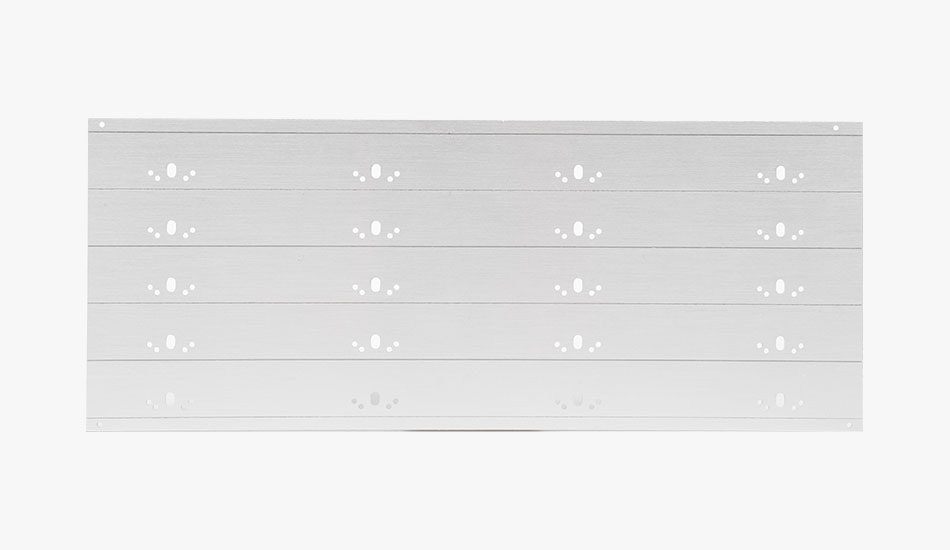-
- PCB TYPE
- PRINTED CIRCUIT BOARD PROTOTYPE ALUMINUM PRINTED CIRCUIT BOARD R&F PCB FPC HIGH FREQUENCY PCB HIGH-TG PCB HEAVY COPPER PCB HDI PCB PCB FOR LIGHTING METAL CORE PCB
time:Jun 06. 2025, 10:25:12
In the rapidly advancing field of electronics, the demand for efficient heat dissipation has become a critical factor in designing reliable and high-performance devices. High Thermal Aluminum Metal PCBs (Printed Circuit Boards) have emerged as a cutting-edge solution, specifically engineered to address the challenges of thermal management in power-dense applications. These specialized PCBs leverage the exceptional thermal conductivity of aluminum, combined with innovative layer structures, to provide unmatched heat dissipation capabilities while maintaining electrical integrity and mechanical stability.
As industries such as LED lighting, power electronics, automotive, and aerospace continue to push the boundaries of miniaturization and power efficiency, the role of High Thermal Aluminum Metal PCBs has grown exponentially. By integrating a robust aluminum core with advanced dielectric and copper layers, these PCBs enable components to operate at optimal temperatures, extending lifespan and enhancing overall system performance. This article explores the design, applications, and advantages of High Thermal Aluminum Metal PCBs, highlighting their significance in modern electronics.

Structure and Material Composition
Aluminum Core Layer
The foundation of a High Thermal Aluminum Metal PCB is its aluminum core layer, which serves as both a heat sink and a mechanical support structure. Aluminum is chosen for its high thermal conductivity, allowing it to rapidly absorb and distribute heat generated by components such as power transistors, LEDs, and microprocessors. Unlike traditional non-metal PCBs, the aluminum core provides a low-resistance pathway for heat transfer, reducing hotspots and ensuring uniform temperature distribution across the board.
Additionally, aluminum offers excellent mechanical strength and lightweight properties. In applications where weight is a critical factor—such as aerospace or portable electronics—the aluminum core helps reduce overall device mass without compromising durability. Its resistance to corrosion and ability to withstand thermal cycling further make it ideal for harsh operating environments.
Dielectric Layer
Sandwiched between the aluminum core and the copper circuit layer, the dielectric layer plays a dual role in electrical insulation and thermal conduction. High thermal dielectric materials, such as ceramic-filled epoxies or polyimide composites, are specifically formulated to balance two key functions: preventing electrical short circuits between the copper traces and the aluminum core while facilitating efficient heat transfer.
The thickness and composition of the dielectric layer are carefully optimized. Thinner layers enhance thermal conductivity but must maintain sufficient dielectric strength to handle voltage requirements. Advanced materials with high thermal conductivity values ensure that heat is quickly transferred from the copper layer to the aluminum core, minimizing thermal resistance and improving overall cooling efficiency.
Copper Circuit Layer
The copper circuit layer is responsible for carrying electrical signals and power within the PCB. High-purity copper is used for its exceptional electrical conductivity, ensuring minimal signal loss and low resistance even in high-current applications. The copper traces are etched to precise specifications, allowing for complex circuit designs and fine-pitch layouts required in modern electronics.
To enhance solderability and protect against corrosion, the copper layer undergoes surface finishing processes such as immersion tin, electroless nickel immersion gold (ENIG), or organic solderability preservative (OSP). These finishes also improve the reliability of component connections, ensuring long-term performance in demanding environments.
Thermal Management Capabilities
The primary advantage of High Thermal Aluminum Metal PCBs lies in their superior thermal management capabilities. In traditional PCBs made from fiberglass-reinforced epoxy (FR-4), heat dissipation is often inefficient, leading to component overheating and reduced lifespan. High Thermal Aluminum Metal PCBs address this by leveraging the aluminum core’s ability to conduct heat away from active components at a much faster rate.
When components generate heat, the aluminum core acts as a heat spreader, distributing thermal energy across its surface and dissipating it into the surrounding environment. This is particularly critical in applications such as high-power LED lighting, where excessive heat can degrade light output and color accuracy. By maintaining lower operating temperatures, these PCBs enhance component reliability, reduce the need for additional cooling solutions (such as fans or heat sinks), and contribute to more compact and energy-efficient designs.
The thermal performance of High Thermal Aluminum Metal PCBs is further optimized through strategic design elements such as thermal vias. These vias create direct pathways for heat to travel from the copper traces through the dielectric layer to the aluminum core, enhancing heat transfer efficiency and reducing thermal stress on components.
Manufacturing Process
Material Preparation
The manufacturing process begins with the selection and preparation of high-quality materials. The aluminum core is cleaned and treated to remove contaminants, ensuring optimal adhesion with the dielectric layer. The copper foil is inspected for defects and cut to the required dimensions, while the dielectric material is prepared as a pre-impregnated film or liquid resin.
Lamination
The lamination process involves bonding the dielectric layer to the aluminum core and the copper foil to the dielectric layer. This is typically done using high-pressure and temperature-controlled presses to ensure a uniform bond without voids or delaminations. The precise control of lamination parameters is crucial for maintaining the PCB’s thermal and mechanical performance.
Circuit Pattern Formation
Using photolithography, a photosensitive resist is applied to the copper layer and exposed to ultraviolet (UV) light through a mask with the desired circuit pattern. The exposed resist is developed, and the underlying copper is etched away, leaving the circuit traces. Advanced etching techniques, such as dry etching or laser ablation, are used for fine-pitch applications to ensure precision and consistency.
Drilling and Plating
Holes are drilled for vias, component mounting, and electrical connections. These holes are then plated with copper to create conductive pathways between layers. The plating process ensures reliable electrical connectivity and mechanical strength, especially for through-hole components.
Surface Finishing
The final step involves applying a surface finish to the copper traces. Choices such as ENIG or immersion tin provide a protective layer that prevents oxidation and enhances solderability, ensuring reliable component attachment during assembly.
Quality Assurance
High Thermal Aluminum Metal PCBs undergo rigorous testing, including electrical continuity checks, insulation resistance tests, and thermal impedance measurements. Automated optical inspection (AOI) and X-ray imaging are used to detect defects, ensuring that each PCB meets strict quality standards for performance and reliability.
Applications in Diverse Industries
LED Lighting
In the LED lighting sector, High Thermal Aluminum Metal PCBs are indispensable for high-power applications such as streetlights, industrial fixtures, and automotive headlights. LEDs generate significant heat, and efficient thermal management is essential to maintain brightness, color consistency, and lifespan. These PCBs enable compact LED designs by eliminating the need for bulky heat sinks, making them ideal for modern, energy-efficient lighting solutions.
Power Electronics
Power supplies, inverters, and motor control units rely on High Thermal Aluminum Metal PCBs to handle high currents and dissipate heat from power semiconductors like MOSFETs and IGBTs. The aluminum core ensures that these components operate within safe temperature ranges, preventing thermal runaway and improving the reliability of power electronics systems in industrial and renewable energy applications.
Automotive Electronics
In automotive systems, including engine control units (ECUs), ADAS (Advanced Driver-Assistance Systems), and LED lighting, these PCBs withstand harsh conditions such as vibrations, temperature fluctuations, and electromagnetic interference (EMI). The lightweight aluminum core also contributes to fuel efficiency by reducing the weight of electronic modules, making them essential for both traditional and electric vehicles.
Consumer Electronics
In high-performance consumer devices like gaming laptops, VR headsets, and fast-charging power banks, High Thermal Aluminum Metal PCBs manage heat generated by powerful processors and batteries. Their compact design and thermal efficiency enable manufacturers to create slimmer, more reliable devices without compromising on performance.
Aerospace and Defense
Aerospace applications, such as avionics and satellite systems, require PCBs that can operate in extreme temperatures and withstand mechanical stress. High Thermal Aluminum Metal PCBs deliver consistent thermal performance in these environments, ensuring the reliability of critical systems like navigation, communication, and radar.
Design Considerations
Thermal Layout Optimization
Designers must prioritize component placement to maximize heat dissipation. High-power components should be positioned over the aluminum core, with thermal vias strategically placed to facilitate heat flow. Avoiding dense component clusters in areas with poor heat dissipation can prevent localized overheating.
Mechanical Stability
Given the aluminum core’s rigidity, designers must consider the PCB’s mechanical properties during layout. Reinforced mounting points and stress-relief features can mitigate damage from vibrations or thermal expansion mismatches between components and the board.
EMI/RFI Suppression
The aluminum core can act as a partial shield against electromagnetic interference, but careful trace routing and grounding strategies are still essential. Separating high-frequency signals from power traces and using ground planes can further reduce EMI, ensuring compliance with industry standards.
Material Compatibility
Selecting dielectric and copper materials with thermal expansion coefficients (CTE) matched to aluminum is critical to prevent delamination over time. Advanced dielectric materials, such as ceramic-filled polymers, help minimize CTE mismatches and enhance long-term reliability.
Advantages Over Traditional PCBs
Superior Thermal Performance
Compared to FR-4 PCBs, High Thermal Aluminum Metal PCBs offer up to [X] times better thermal conductivity, enabling faster heat dissipation and lower component temperatures. This eliminates the need for external cooling systems in many applications, reducing complexity and cost.
Mechanical Robustness
The aluminum core provides inherent mechanical strength, making these PCBs more resistant to bending, vibration, and impact. This durability is particularly valuable in automotive and industrial settings where traditional PCBs might fail due to mechanical stress.
Lightweight Design
Aluminum’s low density allows for lighter PCBs compared to those with copper or steel cores, supporting weight reduction goals in aerospace and portable electronics. This lightweight design does not compromise on thermal or electrical performance.
Cost-Effectiveness
While High Thermal Aluminum Metal PCBs may have a higher upfront cost than FR-4 PCBs, their long-term cost savings are significant. Reduced need for cooling components, improved reliability, and extended product lifespans make them a cost-effective choice for high-power applications.
Future Trends and Innovations
Advanced Materials Development
Ongoing research into high thermal dielectric materials, such as graphene-enhanced composites, aims to further improve heat transfer efficiency. These materials could reduce thermal resistance even further, enabling smaller and more powerful electronic devices.
Integration with Additive Manufacturing
3D printing technologies are being explored to create complex thermal vias and multi-layer structures, enhancing heat dissipation in three dimensions. This could revolutionize PCB design by allowing more efficient heat flow in compact layouts.
Sustainable Manufacturing
As environmental regulations tighten, manufacturers are focusing on eco-friendly materials and processes. Recyclable aluminum cores and lead-free soldering techniques are becoming standard, aligning High Thermal Aluminum Metal PCBs with global sustainability goals. Miniaturization and High-Density Integration
The trend toward smaller, more integrated electronics will drive the development of High Thermal Aluminum Metal PCBs with finer trace widths and multi-layer configurations. These advancements will support the growing demand for compact, high-performance devices in IoT, wearables, and autonomous systems.
Conclusion
High Thermal Aluminum Metal PCBs have revolutionized thermal management in electronics, offering a robust combination of heat dissipation, mechanical strength, and electrical reliability. As industries continue to prioritize energy efficiency and miniaturization, these PCBs will remain a cornerstone in the design of advanced electronic systems. With ongoing innovations in materials and manufacturing, High Thermal Aluminum Metal PCBs are poised to enable the next generation of reliable, high-performance devices across diverse sectors, from automotive to aerospace and beyond.

Got project ready to assembly? Contact us: info@apollopcb.com



We're not around but we still want to hear from you! Leave us a note:

Leave Message to APOLLOPCB
